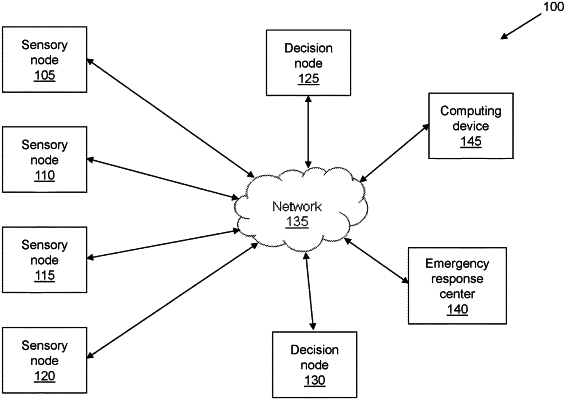| CPC G08B 7/066 (2013.01) [G08B 17/06 (2013.01); G08B 17/103 (2013.01); G08B 21/22 (2013.01); G08B 25/009 (2013.01); G08B 27/001 (2013.01)] | 20 Claims |

|
1. A system for detecting dangerous conditions in a structure and determining one or more evacuation routes for occupants of the structure, the system comprising:
a sensory node, the sensory node comprising:
a sensor;
a power source;
a transceiver;
a processor in electrical communication with the power source; and
a memory, the memory comprising instructions which cause the processor to:
receive a condition value from the sensor;
transmit, using the transceiver, a digital signal, the digital signal comprising a trailing edge;
transmit after the trailing edge of the digital signal, using the transceiver, an analog signal representing the condition value;
transmit a sensory node identifier;
a decision node, the decision node comprising:
a power source;
a transceiver;
a processor in electrical connection with the power source; and
a memory, the memory comprising instructions which cause the processor to:
receive from the sensory node, a first signal and in response to the first signal, sending a signal to the sensory node that changes a behavior of the sensory node, the first signal comprising a digital component and an analog component, the analog component located after a trailing edge of the digital signal;
identify a first hazardous condition from a trend identified using the analog signal component and previously received analog signal components from the sensory node;
using the sensory node identifier, identify the location of the sensory node from which the first signal was received;
receive occupancy data from the sensory node;
determine an occupancy level in the vicinity of the sensory node;
determine a first evacuation route from the location of the sensory node to an exit from the structure wherein the first evacuation route is determined from the layout of the structure and at least partially using the occupancy level; and
determine a second evacuation route from the location of the sensory node to an exit from the structure if the first evacuation route cannot accommodate a number of occupants identified by the occupancy level.
|